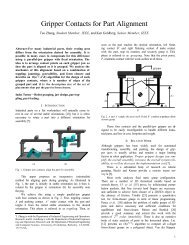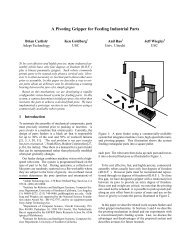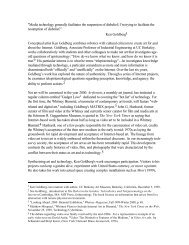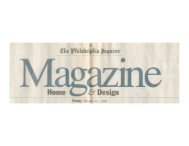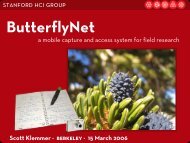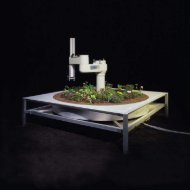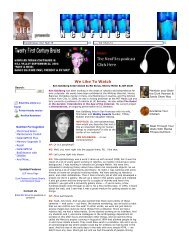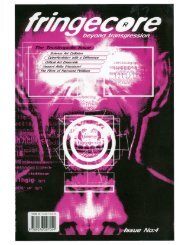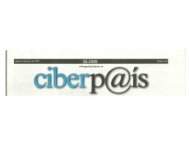0.5MB .pdf - Ken Goldberg - University of California, Berkeley
0.5MB .pdf - Ken Goldberg - University of California, Berkeley
0.5MB .pdf - Ken Goldberg - University of California, Berkeley
Create successful ePaper yourself
Turn your PDF publications into a flip-book with our unique Google optimized e-Paper software.
1364 THE INTERNATIONAL JOURNAL OF ROBOTICS RESEARCH / November/December 2008<br />
been used in a variety <strong>of</strong> robotics applications, including planning<br />
paths for mobile robots (Dean et al. 1995 LaValle and<br />
Hutchinson 1998 Ferguson and Stentz 2004 LaValle 2006).<br />
Past work has investigated needle insertion planning in situations<br />
where s<strong>of</strong>t tissue deformations are significant and can<br />
be modeled. Several groups have estimated tissue material<br />
properties and needle/tissue interaction parameters using tissue<br />
phantoms (DiMaio and Salcudean 2003a Crouch et al.<br />
2005) and animal experiments (Kataoka et al. 2002 Simone<br />
and Okamura 2002 Okamura et al. 2004 Kobayashietal.<br />
2005 Beverly et al. 2005 King et al. 2007). Our past work addressed<br />
planning optimal insertion locations and insertion distances<br />
for rigid symmetric-tip needles to compensate for twodimensional<br />
tissue deformations predicted using a finite element<br />
model (Alterovitz et al. 2003a,b,c). We previously also<br />
developed a different two-dimensional planner for bevel-tip<br />
steerable needles to explicitly compensate for the effects <strong>of</strong> tissue<br />
deformation by combining finite element simulation with<br />
numeric optimization (Alterovitz et al. 2005a). This previous<br />
approach assumed that bevel direction can only be set once<br />
prior to insertion and employed local optimization that can fail<br />
to find a globally optimal solution in the presence <strong>of</strong> obstacles.<br />
Past work has also considered insertion planning for needles<br />
and related devices capable <strong>of</strong> following curved paths<br />
through tissues using different mechanisms. One such approach<br />
uses slightly flexible symmetric-tip needles that are<br />
guided by translating and orienting the needle base to explicitly<br />
deform surrounding tissue, causing the needle to follow<br />
a curved path (DiMaio and Salcudean 2003b Glozman<br />
and Shoham 2007). DiMaio and Salcudean (2003b) developed<br />
a planning approach that guides this type <strong>of</strong> needle around<br />
point obstacles with oval-shaped potential fields. Glozman and<br />
Shoham (2007) also addressed symmetric-tip needles and approximated<br />
the tissue using springs. Another steering approach<br />
utilizes a standard biopsy cannula (hollow tube needle) and<br />
adds steering capability with an embedded pre-bent stylet that<br />
is controlled by a hand-held, motorized device (Okazawa et al.<br />
2005). A recently developed “active cannula” device is composed<br />
<strong>of</strong> concentric, pre-curved tubes and is capable <strong>of</strong> following<br />
curved paths in a “snake-like” manner in s<strong>of</strong>t tissue or<br />
open space (Webster et al. 2006b).<br />
Integrating motion planning for needle insertion with intraoperative<br />
medical imaging requires real-time localization <strong>of</strong><br />
the needle in the images. Methods are available for this purpose<br />
for a variety <strong>of</strong> imaging modalities (Cleary et al. 2003<br />
DiMaio et al. 2006a). X-ray fluoroscopy, a relatively lowcost<br />
imaging modality capable <strong>of</strong> obtaining images at regular<br />
discrete time intervals, is ideally suited for our application<br />
because it generates two-dimensional projection images<br />
from which the needle can be cleanly segmented (Cleary et al.<br />
2003).<br />
Medical needle insertion procedures may also benefit from<br />
the more precise control <strong>of</strong> needle position and velocity made<br />
possible through robotic surgical assistants (Howe and Mat-<br />
suoka 1999 Taylor and Stoianovici 2003). Dedicated robotic<br />
hardware for needle insertion is being developed for a variety<br />
<strong>of</strong> medical applications, including stereotactic neurosurgery<br />
(Masamune et al. 1998), computed tomography (CT)-guided<br />
procedures (Maurin et al. 2005), magnetic resonance compatible<br />
surgical assistance (Chinzei et al. 2000 DiMaio et al.<br />
2006b), thermotherapy cancer treatment (Hata et al. 2005) and<br />
prostate biopsy and therapeutic interventions (Fichtinger et al.<br />
2002 Schneider et al. 2004).<br />
1.2. Our Contributions<br />
Downloaded from<br />
http://ijr.sagepub.com at UNIV CALIFORNIA BERKELEY LIB on November 25, 2008<br />
In Section 3, we first introduce a motion planner for Dubins<br />
cars with binary left/right steering subject to a constant turning<br />
radius rather than the typical minimum turning radius. This<br />
model applies to an idealized steerable needle whose motion is<br />
deterministic: the needle exactly follows arcs <strong>of</strong> constant curvature<br />
in response to insertion actions. Our planning method<br />
utilizes an efficient discretization <strong>of</strong> the state space for which<br />
error due to discretization can be tightly bounded. Since any<br />
feasible plan will succeed with 100% probability under the deterministic<br />
motion assumption, we apply the traditional motion<br />
planning objective <strong>of</strong> computing a shortest path plan from the<br />
current state to the target.<br />
In Section 4, we extend the deterministic motion planner to<br />
consider uncertainty in motion and introduce a new planning<br />
objective: maximize the probability <strong>of</strong> success. Unlike the objective<br />
function value <strong>of</strong> previous methods that consider motion<br />
uncertainty, the value <strong>of</strong> this new objective function has<br />
physical meaning: it is the probability that the needle tip will<br />
successfully reach the target during the insertion procedure. In<br />
addition to this intuitive meaning <strong>of</strong> the objective, our problem<br />
formulation has a secondary benefit: all data required for planning<br />
can be measured directly from imaging data without requiring<br />
tweaking <strong>of</strong> user-specified parameters. Rather than assigning<br />
costs to insertion distance, needle rotation, etc., which<br />
are difficult to estimate or quantify, our method only requires<br />
the probability distributions <strong>of</strong> the needle’s response to each<br />
feasible action, which can be estimated from previously obtained<br />
images.<br />
Our method formulates the planning problem as a MDP<br />
and computes actions to maximize the probability <strong>of</strong> success<br />
using infinite horizon DP. Solving the MDP using DP has<br />
key benefits particularly relevant for medical planning problems<br />
where feedback is provided at regular time intervals using<br />
medical imaging or other sensor modalities. Like a wellconstructed<br />
navigation field, the DP solver provides an optimal<br />
action for any state in the workspace. We use the DP<br />
look-up table to automatically optimize the needle insertion<br />
point. Integrated with intra-operative medical imaging, this DP<br />
look-up table can also be used to optimally steer the needle in<br />
the operating room without requiring costly intra-operative replanning.<br />
Hence, the planning solution can serve as a means <strong>of</strong><br />
control when integrated with real-time medical imaging.



